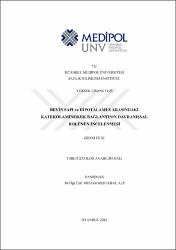| dc.contributor.advisor | Alp, Muhammed İkbal | |
| dc.contributor.author | Filiz, Gizem | |
| dc.date.accessioned | 2021-07-08T07:53:33Z | |
| dc.date.available | 2021-07-08T07:53:33Z | |
| dc.date.issued | 2019 | en_US |
| dc.date.submitted | 2019-08-02 | |
| dc.identifier.citation | Filiz, G. (2019). Beyin sapı ve hipotalamus arasındaki katekolaminerjik bağlantının davranışsal rolünün incelenmesi. (Yayınlanmamış yüksek lisans tezi). İstanbul Medipol Üniversitesi Sağlık Bilimleri Enstitüsü, İstanbul. | en_US |
| dc.identifier.uri | https://hdl.handle.net/20.500.12511/7527 | |
| dc.description.abstract | Besin alımı hayatta kalmak için kritik bir önem taşımaktadır. Ancak beslenme miktarı ve beslenme zamanının fizyolojik dengelere uygun olmayışı bir takım olumsuz etkilere yol açabilmektedir. Yemek yeme arzusunun kalori gereksiniminden, lezzetli yiyeceklerin görünüşüne, günün saatinden, sosyal yaşamdaki olaylar ve duygudurum ile ilgili bağlamlara kadar birçok nedeni olabilmektedir. Bu sebeple iştahı düzenleyen sinir devrelerini ve bu devreler içerisinde çalışan sinaptik mekanizmaları anlamak vücut homeostazının korunmasında önemlidir. Yapılan bu çalışmada, beyin sapında bulunan Tirozin hidroksilaz ifade eden nöronların yoğun olduğu Nükleus Traktus Solitarius (NTS) bölgesinin, vücudun iç dengesinin düzenlenmesinden sorumlu olan hipotalamus bölgesinde bulunan Paraventriküler çekirdeğin (PVN) üzerindeki beslenme ve stres davranışına olan etkisi incelenmiştir. Paraventriküler bölgesinin, nükleus traktus solitarius bölgesinden katekolaminerjik projeksiyonlar morfolojik olarak karakterize edilip, yoğun bir şekilde afferent nöronal sinyaller aldığı bulunmuştur. Beyin sapı terminallerinden gelen bu bilginin hipotalamus üzerinde etkisinin tam olarak ne olduğunun hücre tipi spesifik yeni bir nörostimülasyon tekniği olan optogenetik metodla analiz edilmesi araştırmamızın odak noktasını oluşturmaktadır. Bunun için TH (Tirozin hidroksilaz) transgenik fare gruplarında optogenetik teknik kullanılarak NTS'den PVN'e gelen katekolaminerjik projeksiyonlar uyarılarak davranış kayıtları alınmıştır. Bu bağlantılardan PVN'e odaklanılarak NTS'den PVN'e gelen katekolaminerjik projeksiyonların nörepinefrin salgılamasıyla besin alımını artıcı etki oluşturdukları tesbit edilmiştir. Çalışmanın diğer bir kolunda ise ilgili bölgedeki nörepinefrin salınımının stres üzerinde olan etkisi incelenmiştir. Yapılan stres testleri sonucuyla da stresle ilgili bir bağlantısının olabileceği düşünülmüştür. Bu çalışmayla NTS terminallerinden gelen bilginin paraventriküler hipotalamus üzerinde oreksijenik bir etkisinin olduğu, bununla birlikte stres yolaklarıyla da muhtemel bir bağlantısı olabileceğine dair önemli bulgular elde edilmiştir. | en_US |
| dc.description.abstract | Food intake is critical to survival. However, the amount of nutrition and the non- compliance of the feeding time with physiological balances can lead to some negative effects. The desire to eat can have many causes, from the caloric requirement to the appearance of delicious food, the time of day, to the contexts of events and moods in social life. For this reason, it is important to understand the nerve circuits that regulate appetite and the synaptic mechanisms that work in these circuits in maintaining body homeostasis. In this study, the effect of the Nucleus Tractus Solitarius (NTS) region in which the tyrosine hydroxylase expressing neurons in the brainstem is concentrated on the nutrition and stress behavior on the Paraventricular nucleus (PVN), which is responsible for the regulation of the internal balance of the body, was examined. Catecholaminergic projections of the paraventricular region from the nucleus tract solitarius were morphologically characterized and received intense afferent neuronal signals. The focus of our research is to analyze the exact effect of this information from the brain stem terminals on the hypothalamus by optogenetic method, a new cell-type specific neurostimulation technique. For this, behavioral recordings were obtained by stimulating catecholaminergic projections from NTS to PVN using optogenetic technique in TH (Tyrosine hydroxylase) transgenic mouse groups. From these connections, focusing on PVN, catecholaminergic projections from NTS to PVN have been found to increase nutrient uptake by secretion of neuropinephrine. In another arm of the study, the effect of neurrepinephrine release on stress was investigated. As a result of the stress tests, it was thought that there might be a connection about stress. In this study, it has been shown that the information from the NTS terminals has an orexigenic effect on the paraventricular hypothalamus, but may also have a possible correlation with the stress pathways. | en_US |
| dc.language.iso | tur | en_US |
| dc.publisher | İstanbul Medipol Üniversitesi Sağlık Bilimleri Enstitüsü | en_US |
| dc.rights | info:eu-repo/semantics/openAccess | en_US |
| dc.subject | Hipotalamus | en_US |
| dc.subject | Optogenetik | en_US |
| dc.subject | Nükleus Traktus Solitarius | en_US |
| dc.subject | Paraventriküler Nükleus | en_US |
| dc.subject | Stres | en_US |
| dc.subject | Besin Alımı | en_US |
| dc.subject | Hypothalamus | en_US |
| dc.subject | Optogenetics | en_US |
| dc.subject | Nucleus Tractus Solitarius | en_US |
| dc.subject | Paraventricular Nucleus | en_US |
| dc.subject | Anxiety | en_US |
| dc.subject | Food Intake | en_US |
| dc.title | Beyin sapı ve hipotalamus arasındaki katekolaminerjik bağlantının davranışsal rolünün incelenmesi | en_US |
| dc.title.alternative | Investigation of the behavioral role ofcathololaminergic connection between brain stem andhypotalamus | en_US |
| dc.type | masterThesis | en_US |
| dc.department | İstanbul Medipol Üniversitesi, Sağlık Bilimleri Enstitüsü, Fizyoloji Ana Bilim Dalı | en_US |
| dc.relation.publicationcategory | Tez | en_US |


















